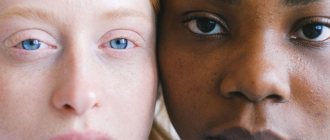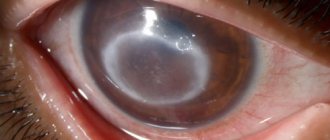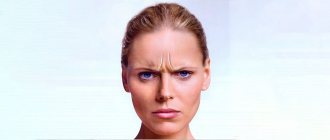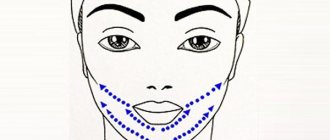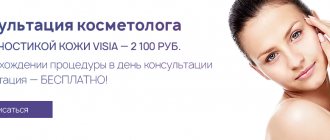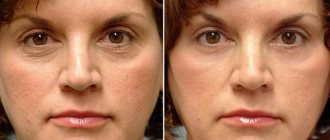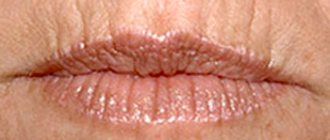| "Before and after" | Prices | Reviews | Doctors | Sign up |
It is impossible to completely get rid of wrinkles around the eyes, but modern cosmetology offers a number of effective procedures that help not only make wrinkles much less noticeable, but also slow down the aging process of facial skin.
| Correction of facial wrinkles around the eyes, the drug Dysport: Doctor: Drobysheva Ya.S. |
What does the procedure give?
Laser resurfacing of the lower eyelids stimulates the division of fibroblasts - cells responsible for the production of collagen and elastin. The skin is evened out and becomes elastic. Venous outflow improves, swelling and “bags” under the eyes disappear. Thanks to laser resurfacing of the upper eyelids, wrinkles are reduced, the skin is tightened and acquires a healthy shade. The periorbital area and the upper third of the face are noticeably rejuvenated.
Price
| Laser resurfacing of face and body TOP CO2 | |
| Face+eyelids | RUB 28,100 |
| Face+eyelids+neck | RUB 32,450 |
| Upper eyelids | RUB 6,700 |
| Suture of the upper eyelids after blepharoplasty | RUB 3,700 |
| Lower eyelids | RUB 6,700 |
| Upper+lower eyelids | RUB 10,600 |
| Scar, scar beyond 1 cm (sq.) | RUB 1,650 |
| Anesthesia (application) small zone | 500 rub |
| Laser resurfacing of face and body Extra – Rubin | |
| Face+eyelids | RUR 33,750 |
| Face+eyelids+neck | RUB 38,950 |
| Upper eyelids | RUB 8,580 |
| Suture of the upper eyelids after blepharoplasty | RUB 4,600 |
| Lower eyelids | RUB 8,580 |
| Upper+lower eyelids | RUB 13,200 |
| Scar, scar beyond 1 cm (sq.) | RUB 1,980 |
| Scar, scar for 1 sq. cm (double grinding along the scar) | RUB 2,100 |
| Anesthesia (application) small zone | 500 rub |
| Laser resurfacing L-Rubin face and body | |
| Upper eyelids | RUB 4,600 |
| Lower eyelids | RUB 4,600 |
| Upper+lower eyelids | RUB 8,250 |
| Scar, scar beyond 1 cm (sq.) | RUB 1,550 |
| Scar, scar for 1 cm (sq.) double grinding along the scar | RUB 1,700 |
| Anesthesia (application) small zone | 500 rub |
Sign up for a consultation
When will the result be noticeable?
The first visible changes occur within a few days after the procedure. First, small wrinkles are smoothed out. The skin becomes lighter and smoother due to the renewal of the surface layers of the epithelium.
After a week, loose folds of skin are tightened. Deep wrinkles are reduced. If you compare photos before and after laser eyelid rejuvenation, the maximum effect will be noticeable after a month. The results last for 3-5 years. Then the course can be repeated.
In what cases is laser eyelid resurfacing recommended?
The possibility of carrying out the procedure is discussed at the initial consultation with a cosmetologist. The doctor takes into account the patient’s age, the condition of the skin and the nature of the aesthetic defect. Laser resurfacing of the skin of the eyelids can be carried out both as a preventive measure, as a basic procedure for rejuvenating the skin of the eyelids, and as a planned procedure after eyelid surgery, when it is necessary to accelerate regeneration and make the stitches invisible after Previously performed blepharoplasty of the upper or lower eyelids.
Laser resurfacing of the skin around the eyes helps solve the following problems:
- slight sagging of the upper eyelid;
- wrinkles of the periorbital area;
- drooping or slight age-related ptosis of the upper eyelid;
- swelling, bags, dark circles around the eyes;
- hyperpigmentation and capillary network;
- small hernias of the eyelids;
- sutures after previous eyelid surgery
- scars and other skin defects.
Contraindications
Laser resurfacing of the upper eyelids is not performed if the patient has:
- viral infection;
- inflammatory processes in the periorbital area;
- systemic autoimmune pathologies;
- bronchial asthma;
- malignant tumors.
Fractional laser rejuvenation: the essence of the method
Using the light energy of a laser beam allows you to have a deep effect on the skin, stop the aging process, and restore the elasticity of the eyelids.
The main advantage of fractional photothermolysis is that it is less traumatic when exposed to the skin - the beam hits the skin as if it were passed through a mesh, with each procedure 15-25% of old tissue can be removed, healthy young skin is formed in its place, one part of the skin cells evaporates, and the other remains untouched.
When carrying out fractional laser rejuvenation of the skin around the eyes, the radiation parameters are selected individually, and the impact is carried out strictly on certain areas. As a result, damage to the epidermis is minimal, only problem areas are affected.
How does laser resurfacing of the skin around the eyes work?
Before the procedure, a consultation is carried out, the goals of which are to exclude contraindications and familiarize the patient with the nuances of preparation. Before laser resurfacing of the lower eyelids, you should not sunbathe for 2 weeks. You need to stop taking retinoids and antibiotics 10–14 days before, and antispasmodics and anticoagulants 2–5 days before. It is not advisable to drink alcohol 2-3 days before the procedure.
Laser eyelid resurfacing occurs in the following order:
- Makeup removal, superficial cleansing of the affected area.
- Anesthesia (application).
- Preparation. The doctor adjusts the device. The skin is treated with an antiseptic. The patient's eyes are protected with caps made of medical steel, lubricated with a special ointment that accelerates tissue regeneration.
- The skin of the periorbital zone is treated with a laser. The patient may feel warmth and tingling.
- The skin is treated with an antiseptic and anti-inflammatory or soothing agents are applied.
Recovery period
You may experience discomfort in the eyelid area for two days. This is normal and should not be a cause for concern. Unpleasant phenomena go away on their own. Swelling may also normally be present in the first 3 days after photothermolysis.
The rejuvenating effect can be fully appreciated a month after your visit to the Clinic. To consolidate the result, it is advisable to carry out 3-4 procedures with an interval of 1.5 months.
Modern rejuvenation technology is safe, but if the technique of the procedure is violated or if it is carried out in the presence of contraindications, complications may arise. These include: infection, scar changes, age spots, deep burns. By choosing our Clinic and following all the recommendations of a cosmetologist, you can be sure that the procedure will be painless and the result will be impressive.
Rehabilitation after laser resurfacing of the upper eyelids
The discomfort, swelling and redness that occurs after the procedure disappear spontaneously within 2-3 days, depending on the type of laser and the power of the parameters chosen by the doctor. The swelling goes away completely after 7–10 days. In the first days after grinding, crusts form that cannot be damaged mechanically. They will go away within 5-7 days.
Recommendations after laser resurfacing of the lower eyelids:
- do not touch the skin of your eyes for a day, do not wash your face, do not apply cosmetics;
- do not sunbathe for a month;
- For 2 weeks it is forbidden to visit the sauna, bathhouse, swimming pool, gym;
- Do not carry out aggressive cosmetic procedures for the periorbital area for a month.
At your appointment at the Damas Clinic, you can find out the cost of laser resurfacing of the skin around the eyes and the optimal number of sessions. The experience of doctors and the use of unique equipment that has no analogues in our country guarantee a pronounced anti-age effect and the absence of side effects. The clinic offers several types of lasers. The type of laser and settings parameters are determined by a laser therapist during a face-to-face consultation.
Features of Erbium Laser
The Absolut Honey Clinic uses the German MCL-30 Dermablate erbium laser to rejuvenate the area around the eyes. The production apparatus is capable of generating pulses that penetrate soft tissue to a shallow depth. This ensures the most gentle effect.
Using the device allows you to get an excellent rejuvenating effect, while avoiding burns and extensive damage to soft tissue. The beam acts exclusively on problem areas without affecting surrounding tissue. This modern technology is safe for health, the recovery period after the procedure lasts only a few days.
Photos of completed work
CO2 eye rejuvenation without surgery
The method involves exposing the eyelids to a carbon dioxide laser using a special device. The procedure is completely safe and does not injure the skin. Recovery takes place within a few days.
The peculiarity of CO2 laser eyelid rejuvenation without surgery is its long-term effect. The first visible changes are 2-3 weeks after the session. Over the next 6 months, skin renewal occurs and the rejuvenation effect accumulates.
The procedure is contraindicated in acute infections, diabetes, cancer, and increased tissue susceptibility to scarring. It is not recommended to undergo sessions during pregnancy and while taking certain medications.
What is laser skin rejuvenation
Aging affects all human internal organs and tissues, and so far this process, unfortunately, cannot be stopped. In addition, facial tissues are affected not only by the environment, but also by facial expressions, as well as articulatory and chewing functions. Due to this, facial tissues are very vulnerable.
If facial wrinkles are visible even in a static position of the face, this is the main sign of skin aging. Soft tissues are also deformed, spider veins, neoplasms and age spots appear, and the configuration of the face and neck changes.
Recommended articles on the topic:
- Facial mesotherapy procedure: pros and cons
- Beauty injections: types of drugs, reviews
- Placental therapy is the secret of eternal youth
With age, the collagen framework of the skin weakens, so the tissues sag and facial features sometimes change beyond recognition. From this point of view, wrinkles are not the worst “age-related” problem. Young people have enough collagen in their skin, so the tissues of the face and body successfully resist ptosis. But over time, collagen fibers are poorly produced, as a result of which the skin sags, “jowls” appear under the cheeks, bags under the eyes, the oval of the face becomes unclear, the corners of the eyes and lips droop down, a double chin is visible, etc. Only a surgeon can help you get rid of drooping chin, cheeks and eyelids. It is better to think about this problem in advance and take advantage of laser skin rejuvenation before it is too late.
One of the most effective ways to combat age is lifting. Today there are quite a lot of methods to do a facelift without the intervention of a surgeon, but most of them are unsafe or not as effective as laser rejuvenation. When a client wants to get a quick result, he goes to the clinic for a skin tightening procedure, but in the end there is a very unfavorable effect that contributes to premature aging. There are non-invasive technologies to get rid of sagging skin. Each method has advantages and disadvantages, but fractional facial rejuvenation is the most suitable option for most clients because it produces the desired results without surgery.
Deep chemical peeling and dermabrasion can be considered not entirely relevant methods of rejuvenation, although they have recently been very popular. Laser technology is modern and safe. There is no risk of infection to the patient, and the specialist can accurately control the depth of laser exposure and its uniformity. These are very important advantages.
Let's figure out how laser radiation acts on human skin. Radiation affects biological tissue. Chromophores absorb light in a specific range of wavelengths. Skin structures are 90% water. For water, the wavelength range is the infrared spectrum, for hemoglobin - green, for hair and skin melanin - red. Chromophores absorb laser radiation, as a result of which light energy is converted into heat in the area that contains the substance.
It is worth mentioning radio frequency lifting, which was previously used for skin rejuvenation. It did not bring the expected result and, moreover, was unsafe. There was a risk of atrophy of subcutaneous fat and many other problems. Laser skin rejuvenation is an ideal option for patients; its energy penetrates the skin.
Read material on the topic: Facial mesotherapy procedure: pros and cons
Expert commentary
Kozyreva I. E., Doctor of Medical Sciences, chief physician of the cosmetology clinic:
The laser rejuvenation procedure for the area around the eyes is performed using modern equipment. This allows you to get maximum results in a short time. The risk of complications is minimal. Recovery occurs already on the second or third day after the session.
When carrying out this type of correction, it is important to pre-examine the patient in order to exclude all possible contraindications. The individual characteristics of a person, the anatomical and physiological structure of the periorbital zones are taken into account.
Compared to plastic surgery, laser blepharoplasty has a shorter rehabilitation period, proceeds without complications, and is cheaper.
Laser blepharoplasty
Laser blepharoplasty is a plastic surgery term that refers to surgery to correct eyelid defects. The skin is cut with light rays, tightened and fixed in a new place. But popularly, this term is often used to refer to a completely different procedure, cosmetic - laser resurfacing (or dermabrasion) of the eyelids, which is fundamentally different from surgery. It is grinding that will be discussed in our article, and for convenience we will use the concept of “blepharoplasty” that is familiar to most. Both men and women of different ages often seek this procedure. In this sense, laser blepharoplasty is an effective non-surgical method of rejuvenating the upper and lower eyelids using a light beam. Under the action of the laser, excess soft tissue “evaporates”, as a result the skin shrinks, its relief and turgor improve, and many more problems in the area around the eyes are solved.
Laser hardware cosmetology
How does a laser work?
The meaning of the procedure is the targeted effect of light beams on the epidermis and dermis.
In this case, tissue coagulation occurs, but without cuts or punctures. A laser beam of a certain wavelength is able to influence which chromophore like water, a chromophore is a structure that absorbs a certain wavelength of light. When exposed to a laser beam, water heats up and evaporates with the formation of multiple small areas of dry necrosis.
Advantages and effectiveness of the method
This is the least traumatic method of rejuvenation, which is why many women are inclined in favor of laser blepharoplasty. Advantages of the procedure:
- easy to bear;
- if necessary, appile anesthesia can be used;
- no postoperative sutures, scars, hematomas;
- no complications;
- short rehabilitation period;
- quick result.
The effectiveness of laser blepharoplasty is increased due to its triple action.
Firstly, the area of treated skin is reduced by 5–15%. Secondly, the production of new young collagen and elastin by fibroblasts is stimulated. Thirdly, microcirculation in tissues improves. After laser resurfacing, the skin around the eyes becomes smooth, tightened, and acquires a healthy shade. With minimal interventions, the effect of laser blepharoplasty, depending on age and initial age-related changes, lasts from 2 to 5 years. Depending on the age, genetics and hormonal status of the patient, the number of procedures varies from 1 to 3 per session.
Types of laser exposure
For laser blepharoplasty, two types of beams are used:
- Carbon dioxide or CO2 laser. The wavelength is 10,600 nm; a beam of this wavelength has high thermal output and is capable of aggressively damaging surrounding tissues. Fewer procedures can be performed, but the recovery period will be longer
- Erbium. It has a wavelength of 2,940 nm, the chromophore is also water, but it works more softly and controlled, the recovery period is more gentle, and is considered the gold standard for working on delicate areas.
When is laser eyelid resurfacing needed?
The main goal of laser blepharoplasty is to restore youth to the area around the eyes.
Since it is the thin skin of the eyelids that is more susceptible to aging, as a result of exposure to various environmental factors, it is this area that shows the first age-related changes.
However, grinding can be resorted to at any age, even at a young age, to eliminate cosmetic defects. It will help in the fight against such phenomena:
- excessive dryness of the skin of the eyelids and a decrease in its tone, resulting in noticeable folds and lines;
- facial wrinkles that can form due to negative external factors (ultraviolet radiation, cold, tobacco smoke, habit of squinting);
- “swelling” of the upper and lower eyelids;
- “dark circles” and “bags under the eyes” - we are talking about small hernial sacs; if severe, surgery is needed;
- pigmentation, general unevenness of tone;
- presence of scars;
- correction of an inaccurately healed line in the folds of the eyelid after plastic surgery. This may occur in some patients due to genetics and metabolism. The laser removes excess connective tissue and makes it softer.
Using laser blepharoplasty, you can remove signs of aging and defects, the cause of which lies directly in the skin of the eyelids and is not associated with disruption of the internal organs. For example, severe swelling caused by improper functioning of the kidneys cannot be permanently eliminated using a laser. The procedure will not help with severe ptosis - very severe sagging of the skin of the eyelids; surgery will be required here.
Contraindications
Laser blepharoplasty does not have a wide range of specific contraindications; only sometimes it needs to be canceled or postponed until recovery.
Absolute contraindications include:
- individual intolerance to laser;
- period of pregnancy and lactation;
- oncology;
- serious systemic diseases (epilepsy, psoriasis, diabetes mellitus, autoimmune pathologies);
- genetic predisposition of the skin to the formation of keloid scars.
It is necessary to postpone laser blepharoplasty of the eyelids:
- during a viral or infectious disease (ARVI, influenza, bronchitis);
- during the period of exacerbation of chronic pathologies;
- for dermatological problems on the skin of the eyelids;
- within 2 months after plastic surgery, chemical peeling or other similar cosmetic procedures on the face;
- within 2 weeks after intense tanning under the sun or in a solarium.
When is the best time to have blepharoplasty?
Experts are unanimous in their opinion that the best period for laser blepharoplasty is autumn, winter and spring.
Preparatory stage
At the initial consultation, the cosmetologist talks with the patient and conducts an examination to exclude contraindications.
Medication may be recommended. In addition, the doctor will issue a list of recommendations that are followed until the day of laser resurfacing and throughout the entire rehabilitation period:
- do not sunbathe;
- stop taking hormones, antispasmodics, anticoagulants;
- do not drink alcohol.
There is no need to take tests or undergo examinations.
Equipment and procedure
The laser device consists of three blocks:
- electric - power is supplied through it;
- worker - here electricity is converted into a beam of light;
- optical - with the help of mirrors, light is reflected many times, turning into a wave of a certain frequency and length.
There are several radiation sources on the nozzle, so the treated area does not look like a solid line or area, but many small dots.
The entire process, including patient preparation, takes from 30 minutes to 1 hour. The doctor’s action algorithm will be as follows:
- cleansing the skin of the eyelids with mild cosmetics;
- antiseptic treatment;
- use of local anesthesia if necessary;
- setting up the device - the doctor selects the appropriate radiation range and wavelength;
- processing of the planned areas with the device, while protecting the eyes.
During the procedure, you may feel tingling, heating of the skin, and discomfort. At the final stage, the doctor assesses the condition of the tissues and the patient’s well-being, makes recommendations, after which you can go home. The total time spent in the clinic will be 1-1.5 hours.
Recovery period
Immediately after laser blepharoplasty, eyelid redness and swelling are observed.
This will pass within 2–3 days. By the end of the first day, swelling increases, which resolves within 3-5 days. Also at this time, microscopic crusts form, but they cannot be removed - they must come off on their own. During the rehabilitation period, which lasts 5-10 days, follow the doctor’s recommendations:
- on the first day, do not touch the skin around the eyes, avoid the use of any cosmetics - decorative, for care;
- from the second day you can wash your face with soft cool water and use gentle moisturizers;
- For another month, only light makeup is allowed. The main thing here is to carefully rinse off the pigment, do not rub the skin, or use aggressive agents;
- for 3–4 weeks, avoid baths and saunas, exposure to the sun or visiting a solarium;
- postpone sports and heavy physical labor.
Complete tissue restoration is achieved in 2-3 weeks, with deep resurfacing - 4-6 weeks, the full effect after laser blepharoplasty begins from 6 weeks and increases by 3 months
Possible complications
Depending on the genetics and metabolism of the patient, complications may manifest as swelling over a long period.
If the recommendations are not followed, they can manifest themselves in the form of severe swelling and pigmentation. Remember that such procedures must be carried out by an experienced specialist. An experienced doctor will identify contraindications, prescribe preventive treatment and carry out the procedure technically correctly, which together will minimize all risks.
VIP Academy employs highly qualified doctors with 15 years of experience in performing laser dermabrasion of the lower and upper eyelids.
We use only certified techniques; the device has a cooling option, which makes the procedure more comfortable. The clinic is located in Nizhny Novgorod at the address: st. Studenaya, 57. Find out more details about the procedure by calling 8 (831) 219-91-50.
Types of wrinkles around the eyes
As a rule, the first wrinkles in the form of “crow’s feet” appear in the outer corners of the eyes at 25-30 years of age. Deep wrinkles form at the age of 30-40. This process develops gradually and reaches a peak at 55-60 years.
According to the degree of severity, they are distinguished:
- superficial wrinkles
, they appear the very first and form in the epidermis area. These wrinkles include “crow’s feet”. - deep wrinkles
form in the dermal layer and subcutaneous fat. At the same time, the skin loses its firmness and elasticity, becomes dry, flabby, and begins to sag.
Due to their occurrence, there are three types of wrinkles:
- Facial - develop as a result of strong tension in the facial muscles and excessive facial expressions;
- Age-related - occur as a result of age-related changes in the structures of the skin;
- Gravitational - develop as a result of sagging skin due to loss of elasticity and firmness.
Also, regardless of the causes and severity, all wrinkles are divided into:
- dynamic - not visible when the facial muscles are relaxed;
- static - visually noticeable even in a calm state.

